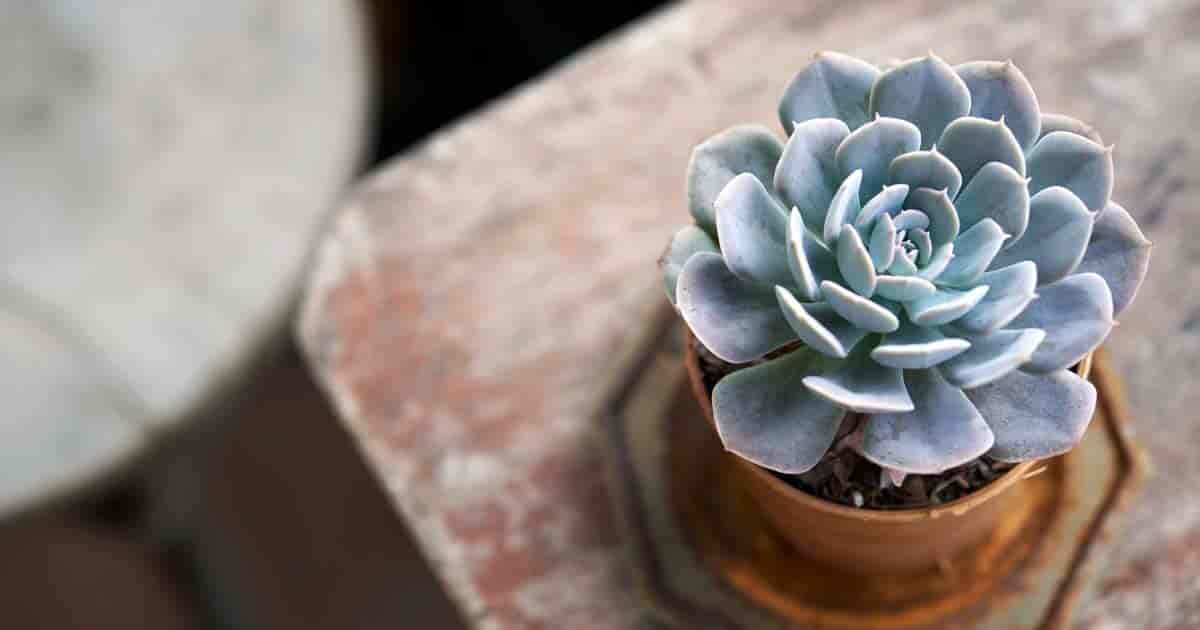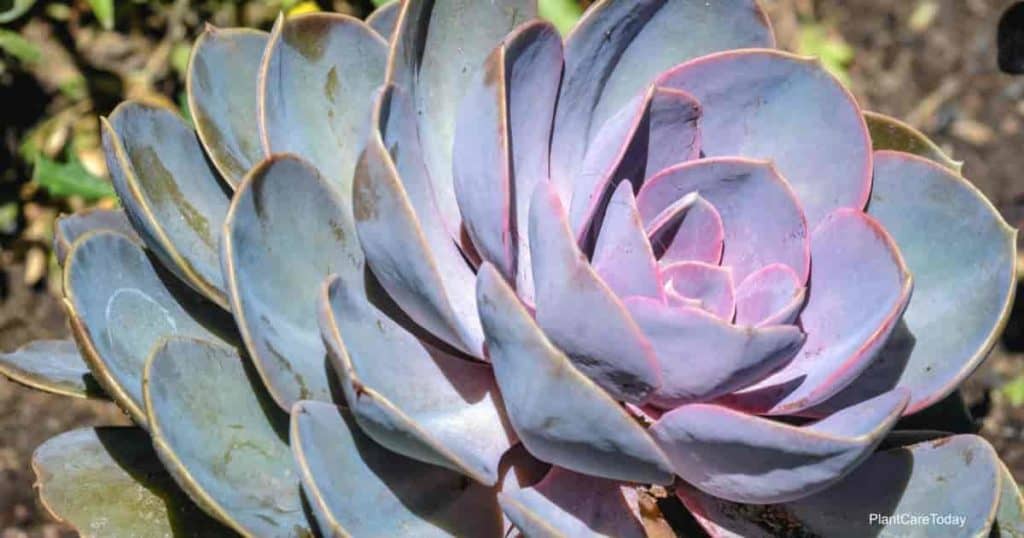The Echeveria plant is a type of succulent that features fleshy leaves and attractive bell-shaped blossoms. Echeveria care is easy.
They produce flowers during spring and summer in colors ranging from palest white to fire engine red and everything in between.

Quick Echeveria Plant Care Guide
- Botanical Name: Echeveria – Check out the many Echeveria types here.
- Common Name: sometimes called Mexican Hen and Chicks
- Family & Origin: Mexico, Central America
- Growability: Easy Care
- Grow Zone: USDA zone 9
- Lifespan: Years
- Size: Rosette form, stemless or stem forming
- Flowering: Spring and Summer
- Light: Full sun and bright sunny location
- Temperature: Upper 70° to low 80° degrees Fahrenheit
- Water: Water well in the growing season, allow the soil to dry before watering again
- Fertilizer: Fertilize with balanced food, no fertilizer in winter
- Pests & Diseases: Aphids, scale, mealybugs, rotting roots from overwatering
- Propagation: Leaf cutting, offsets, seed
Where Do Echeverias Come From?
All of these succulents come from the Americas. Most are from Mexico.
However, there are some species that hail from Central America and South America.
They also grow naturally in Texas and can be found as far south as Argentina. [source] Echeveria is fairly drought tolerant and easy to care for. Let’s look at how to care for Echeveria.
Succulent Echeveria Care

Echeveria succulent care requirements vary somewhat from one species to another. Generally speaking, Echeverias require well-drained soil, light, airy potting mix, full sunlight to partial shade, and very little water once mature.
Size & Growth
These pretty plants are easily recognized by their compact rosette succulent growth habit and their plump, attractive leaves, which may be tinged with red or pink and may even seem to glow in the right light. Often full sun!
Echeveria succulent plants come in many different colors of leaves, including:
- Bright green
- Blue-green
- Dusty gray
- Purple Echeveria
- Black
- Pink
- Red
Flowering and Fragrance
Blooms grow on flower stalks or flower stems in a wide variety of shades that always contrast attractively with the background color of the foliage.
Echeveria Sunlight & Temperature
Echeveria likes bright, indirect sunlight and warm temperatures of the afternoon sun. Many varieties will grow in full sun but may need light shade in scorching summer. Avoid drastic sunlight changes.
It thrives when kept between 70° and 80° degrees Fahrenheit.
In the wintertime, do not let the temperature drop below 40° degrees Fahrenheit. These plants cannot tolerate freezing temps.
How Much Water And Fertilizer Do Echeverias Need?
When watering Echeveria during the growing season, water them thoroughly. Let the potting soil dry out completely before watering again.
Provide them a balanced succulent/cactus food about once a month. In the winter, water lightly and less often. Do not fertilize at all during this resting period.
NOTE: Over-fertilizing these succulent plants can cause fertilizer burn.
Many succulent plant varieties tend to develop rotting roots easily. It is best to water from beneath rather than with overhead watering and keep the soil dry.
Always plant Echeveria in pots with drainage holes.
Those with waxy leaves are especially sensitive to the ill effects often associated with overhead watering.
Water carefully, and don’t splash water on the plant’s leaves because this will leave unsightly spotting on the waxy coating.
More on How Often To Water Echeveria Plants
Soil & Transplanting
Echeverias thrive best in well-drained soil designed for a succulent plant.
Repot young plants annually and mature plants every second year. Repot in spring, using either a special succulent potting mixture or mix your own mix.
Do Echeverias Need Grooming And Pruning?
Echeveria is self-pruning. You will not need to do anything more than remove the occasional dead leaf and blossoms.

Many Succulent Echeveria Types To Choose From!
This is a very large genus of succulent plants (from the stonecrop family) with fleshy leaves in a rosette growth pattern.
Echeveria glauca the very hardy “hen and chick” blue Echeveria plant does so well outdoors in full sun to partial shade in many different regions.
In fact, Hen and Chicks is a common name often applied to this type of plant.
UC Berkeley has a very complete collection of images!
Echeverias can range in size from a few inches high to three or four feet tall. They may be either stemless or stem form.
They grow in a rosette pattern with flat triangular or spatulate leaves. The leaves range in color from pale green to a purplish shade and tend to develop a waxy powder coating.
There are some Echeveria species that are stouter and have very sturdy woody stems.
These taller versions can grow as high as three or four feet. Their lower stems are bare, and they grow larger dish-like rosettes.
These plants have traditionally been crossed with other sorts of plants such as Pachyphyyum, ghost plant Graptopetalum, and Sedum.
Echeveria Varieties – Species and Cultivars
- Echeveria elegans
- Echeveria agavoides (Lipstick Echeveria) resembles Agave plants, with leaf tips darker color.
- Echeveria ‘Black Prince’
- Echeveria ‘Perle Von Nurnberg’
- Echeveria ‘Afterglow’ – wide leaves, powdery pinkish-purple, bright pink edges!
- Echeveria imbricata – produces blue-green leaves forming tight rosettes.
- Echeveria peacockii – beautiful rosette, rich green succulent leaves, easy to grow indoors, avoid overwatering.
- Echeveria lilacina – (Ghost Echeveria) silvery-gray leaves, slow-growing, drought-tolerant.
- Echeveria lola – lavender tones in the leaves
- Echeveria setosa
- Echeveria pulidonis
- Echeveria nodulosa (Painted Echeveria) – multicolored foliage, rosette form with red markings create a ‘painted’ effect.
- Echeveria laui
- Echeveria pulvinata – small rosettes, succulent green leaves
- Echeveria subsessilis (‘Morning Beauty’) – Bluish green leaves form beautiful rosettes with a pink tinge along the leaf margins.
- Echeveria prolifica (Pink Edged Echeveria) – blooms throughout spring and summer, small yellow bell-shaped flowers.
- Echeveria runyonii ‘Topsy Turvy’
- Echeveria cante – (White Echeveria)
- Echeveria derenbergii
- Echeveria shaviana
- Echeveria glauca
- Echeveria chihuahuensis
- Echeveria Green Prince
- Echeveria Purpusorum
Related Reading:
- Graptopetalum Amethystinum (Lavender Pebbles)
- An Echeveria hybrid – Graptoveria Succulents
This cross-breeding produces bigeneric hybrids (Pachyveria, X Graptveria, and X Sedeveria). These hybrid plants display the best characteristics of both parents.
Where Can You Buy Echeveria?
Many garden centers carry a selection of these hardy plants. They are also frequently offered in terrarium collections and gift plant arrangements. Collections can also be purchased online at Amazon.
Because these plants can live for a very long time and reproduce and spread enthusiastically, the most common place to get one is from a gardening friend.
If you do purchase your plant rather than receiving it as a gift, be sure to examine it carefully.
Give the leaves a little squeeze to be sure they are healthy and firm. Look the plant over for signs of pests or rot. You want a plant that has an overall healthy appearance.
Related: Check Out These 30 Cat Safe Indoor Plants
How Do You Propagate Echeveria?
Like most succulents, you can propagate Echeveria from seed, but using leaf cuttings, stem cuttings or offspring plants is easier and more successful.
These plants develop multiple offspring around their base. Growing Echeverias from offsets from the “mother rosette” is the easiest way to increase your collection. If this is not possible, try growing the plant from leaf cuttings.
Leaf Propagation: To grow these plants from leaf cuttings, carefully clip off the number of leaves you need for the number of plants you want.
Choose from mature leaves as these take root more easily.
Prepare a mixture of well-draining soil. You can either purchase succulent soil mix or mix your own by combining regular houseplant potting mix and sand, 50/50.
Place the potting mix in a shallow pan and lay the leaves flat on the surface. Do not water. Instead, place the tray in a comfortably warm, airy setting with plenty of indirect light.
Leave it alone for a few days and then begin watering or misting very lightly, occasionally. The potting mix should be just barely damp.
Within a month, the leaves on your new succulent plant should have begun to send out roots, and new leaves may have started to grow. Begin by giving the plants morning sun.
Wait until the plants gain a little size, then transplant them into small pots.
Before you know it, you will have a nice collection of cute, miniature plants to share with friends or enjoy for yourself.
This video, demonstrates a very carefree method of growing Echeveria and other succulents.
Troubleshooting Echeveria Care Pests or Diseases
With plenty of light, warm air, and careful watering, you should not encounter any problems with these carefree plants.
If you have problems, it is likely due to improper succulent watering habits or problems with temperature and lighting.
Here are a few problems you may encounter with Echeveria care:
Low light may cause the leaves of this succulent plant to become pale and stretched-looking. If this happens, move the plants gradually to a brighter light setting.
Mealybugs may attack these plants. If you notice these little invaders, don’t spray the plant with insecticide. Instead, use an insecticidal soil drench which will circulate through the plant systemically.
Spraying insecticide on an Echeveria plant will disturb the leaves’ waxy coating and cause unsightly spotting.
As with all plants, overwatering will cause root rot. Be sure to let the potting mix dry out almost completely between watering. Remember to limit watering during the autumn and winter months.
Learn more about Echeveria Succulent Pests | Diseases | Solutions
Suggested Uses For Growing Echeveria?
They can be kept as house plants in colder climates and do well as bedding plants in areas that do not freeze.
In a small space, one of these plants works well as a specimen plant. They also do very nicely in indoor succulent gardens and terrariums.
Outdoors, they make excellent additions to rock gardens and succulent gardens. They are also superb container plants.
Whether you keep your Echeveria indoors or outdoors, it’s important to understand that caring for Echeverias begins with lots of sunshine, lots of fresh air, and make sure to not overwater.
If you can provide that plant care, you can enjoy these cheery house plants that are virtually trouble-free.
